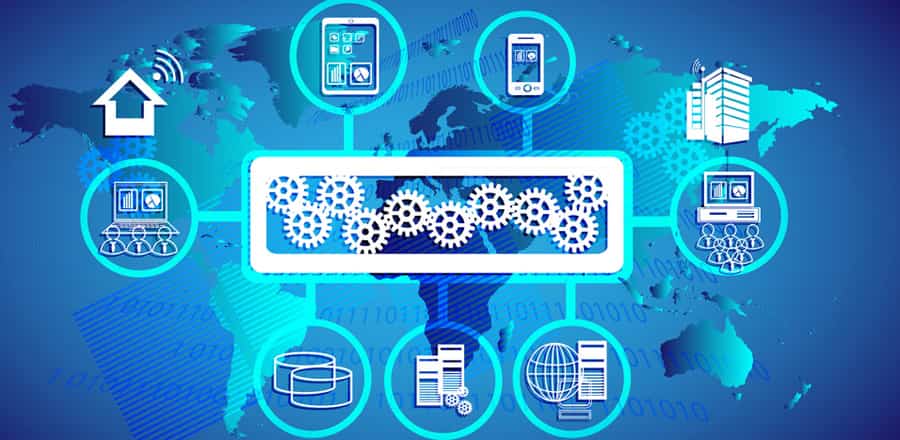Web Browsers can interact with the application services to perform tasks like interacting with the database or other sources to get orders and send greetings or news. The system offers cross-platform interoperability where apps written in Java or Microsoft can be integrated using the web service layer.
This helps to get dynamic integration of apps independent of the technology. Methods like Just in Time integration can get a service provider that publishes the service description through the service registry.
Just-in-Time can happen at runtime, and the client may not know what procedure is used to run. Such systems provide the next stage of evolution for e-commerce – a business where everything is integrated as a service dynamically on-demand – discovered run time through online messaging.
It can be hosted on IIS but is not lightweight as it uses SOAP. It differs from the core APIs hosted with an app or IIS is lightweight, and can support URLs, caching, content formats, response headers/requests, etc.
We provide consultancy regarding end-to-end solutions to all your website and mobile device integration needs. Our consultancy ensures you can meet complex and challenging technical and industrial hassles, from concept and design to testing and implementation.
We are committed to providing collaborative problem-solving, solving sophisticated designs, and quality products to take your business to the next level and build long-lasting relationships with your clients beyond business.
We strive to support your web application integration needs to enable you to achieve the highest goals where the doors are wide open for a wide range of valuable and creative solutions needed for your business growth.

What are Web Services?
Web services provide software, cloud or apps which can provide standardized web protocols like HTTPS and HTTP to exchange data and messages, mostly through XML on the internet. The XML-centric technology uses the internet for A2A – application-to-application communication and interfacing.
Web applications provide ways to create dynamic websites requiring communication technology to interact with the database to provide backend services to present data to the user.
The processes involve interaction with the database to retrieve or send messages, programs, documents or objects. Unlike static websites, which do not require interaction with the database, all the information is held with the front-end program code.

What are the different types of Web Services?
XML-RPC is one of the basic protocols for data exchange between multiple devices and networks. It works on HTTP and can transfer messages from client to server.
WSDL provides information about the services and their functionalities. UDDI offers a distributed directory of web services. It is a kind of internet registry for companies worldwide that aims to streamline transactions and e-commerce data.
SOAP and RESTful technologies are used to integrate mobile-based features without intermediaries. SOAP works on vendor-specific technologies and enables distributed interoperability.

Integration of Web Services
Integration helps in communication and exchange of information where a web service provider enables certain functionalities that can be used by different applications working on different codes. The application can send a request to use the services where the web app is hosted, and the server responds as per the request.

The Use of Web Services for Application Integration
-
New developments in object-oriented methods have changed the A2A and B2B deployment and customization.
-
Earlier, the integration of codes written in C, C++ or COBOL was done through a programming interface (APIs) where concrete data structures were invoked through RPCs across the internet.
-
Later, RMI (Java remote method invocation), Common object request and DCOM were used in the distributed middleware. Now, message-oriented MOM and XML are used with SOAP for such integrations.
-
Business requirements, application architecture, business processes, and enterprise data integration policy determine the use of functions where web services provide standard methods to publish and subscribe to apps over a network.
-
Where client apps can locate the services published by servers using UDDI, WSDL provides information related to the service interface, and XML and SOAP are used for formatting data.
Web Service Integration Example
An example of such situations can be found in mergers where the enterprise integrates the IT systems with the business procedures. This can be found in the travel industry, where computing is largely mainframe-based and exposed to multiple apps through the wrapping.
It can be seen in IBM and Microsoft applications where IBM integrated web services support through the Web Sphere, Lotus, Tivoli, and DB2 products.
It is useful in legacy applications where the security, middleware, and communication technologies are wrapped as the environmental prerequisites.

Website and Mobile Device Integration
Mobile devices run on stationary servers and wireless technologies. A mobile phone works on the WAP browser, which is a microbrowser that is considered internet-capable. The WAP browser accepts a card deck like a tiny Web Page where WML is used to design the layout instead of HTML. The users can navigate the WAP application from the menu.
The structure is based on the minimalist web page concept, where frames and graphical navigation cannot be translated into the menu-oriented structure.
Mobile interaction is now limited to thumb-operated keypads, and the new web services support the required features for such operations. The diverse options offer opportunities for corporate users where the applications could run on a mobile device and interact seamlessly on multiple configurations, Wi-Fi and GPRS.
The integration on mobile can increase the device's functionality and provide benefits like - enabling the owner to have ultimate control over managing, administering and securing mobile-hosted services.
The location-based apps help track the individual's location and are useful for triggering/updating new information.

What are REST and SOAP Web Services?
Though developers use several packaging protocols, SOAP is a packaging format mainly built on XML. The advantage of SOAP is that it is easier to distribute but difficult to set up and develop.
Representational State Transfer or REST is the style based on specific constraints, uniform interface, and architectural style, where unique URLs represent the individual objects. It is applied to improve performance, scalability, and modifiability.
The RESTful web services provide a set of resources that helps interact with the clients where the resources can be identified as URIs – providing global addressing space for service discovery and resources. The server uses HTTP as the supporting protocol.
Self-descriptive messages where resources are decoupled with the representation to help the user access the HTML, PDF and other file formats and the metadata related to the resource are offered to control the caching and negotiate the representation format and performance access control.
A uniform interface is another manipulated application using create, update, read and delete options, i.e. PUT, GET, POST and DELETE.
The advantages of REST are - it is lightweight, easier to build and human-readable, whereas the drawbacks are that it lacks standards and point-to-point communication.

Web Service Architecture
-
The architecture involves the service provider, the service requester, and the service broker, which are used to publish, find and bind.
-
These self-contained modular apps can be published, located, invoked and described over WWW.
-
A WDS document describes the non-operational service information like the service category, description and expiration date, and information like the service provider, the company name, address and contact information.
-
A NASSL document contains information about the service, interface, implementation, access protocol and contact endpoints.
-
The architecture allows incremental security and quality facilitated by configuration needed per the environmental prerequisites.
-
The role of the architecture is to promote interoperability by lowering the requirement for shared understanding. It helps to provide JIT integrations, reduce complexity through encapsulation, and promote interoperability of the legacy software.

Web Service Integration In Android
The first step is to clear up the internal functions to provide flexible, scalable internal infrastructure to support the business. The mobile backend needs HTTPS for every endpoint, and the developmental environment should use the same type of certificates.
Each project has a different requirement for performance and scalability, and one has to evaluate the requirement to determine where to host the server.
The programmer has to stage the architecture and environment so that the structure promotes interoperability and minimizes the requirement for shared understanding between the provider and the requester.
In the last stage, collaborations are created dynamically at the run time, and as the requester identifies the provider's capabilities, it finds the appropriate service.

Spring RESTful Web Services Integration Example
The constraints of RESTful web services are – there should be a service provider and a service consumer. The interface or URL is uniform, and the service is stateless but cacheable and layered.
Spring Boot provides support for creating RESTFul web services for enterprise applications. The Spring Initializr can pull the app's dependencies or use the SpringApplication helper class.
Spring released version 4.0.0 and uses the Jackson JSON integration to send a JSON response. STS tools generate the pom.xml, where one can add the dependencies. Then, the coder has to configure the REST API and deploy it.
Frequently Asked Questions
- What is HTML coding?
-
 It is part of web design involving elements, tags and attributes - the designators are categorized into headings in less than () brackets. The pair of closing and..
It is part of web design involving elements, tags and attributes - the designators are categorized into headings in less than () brackets. The pair of closing and..
-
- What is PHP coding
-
 It is the most widely used server-side programming language that offers fast ways to create dynamic webpages that work well with HTML and multiple types of databases..
It is the most widely used server-side programming language that offers fast ways to create dynamic webpages that work well with HTML and multiple types of databases..
-
- What is a domain name
-
 It refers to the address that can be used to find computers connected on the network through IPs as it is difficult to remember the string of numbers. The names are..
It refers to the address that can be used to find computers connected on the network through IPs as it is difficult to remember the string of numbers. The names are..
-
- How to build a web app
-
 The Web applications UK are dynamic usable pages where client-side code can be written in HTML, CSS or JavaScript and is interpreted by the browsers, while, the..
The Web applications UK are dynamic usable pages where client-side code can be written in HTML, CSS or JavaScript and is interpreted by the browsers, while, the..
-
- What are web applications
-
 The web applications UK are stored on remote servers and accessed on the browser through the internet. It can deliver certain function and some are accessible on..
The web applications UK are stored on remote servers and accessed on the browser through the internet. It can deliver certain function and some are accessible on..
-
- What makes a good website
-
 Some of the best websites have a clear purpose, organized basic elements positioned (on the homepage) as per certain rules, straightforward navigation, clean..
Some of the best websites have a clear purpose, organized basic elements positioned (on the homepage) as per certain rules, straightforward navigation, clean..
-
- What is web design
-
 It is the basic template designed by web developers as a user interface with several visual imageries to determine how the pages of the site will look and work. It..
It is the basic template designed by web developers as a user interface with several visual imageries to determine how the pages of the site will look and work. It..
-
Related Terminology Explained
- How to design a web page
-
 Web pages are essential tools for online marketing. They are designed by every single business and every individual wants to know how to design a web page that will..
Web pages are essential tools for online marketing. They are designed by every single business and every individual wants to know how to design a web page that will..
-
- How to learn web designing
-
 How to learn web designing, Learning the ropes of web design requires time, patience and plenty of practice. There is much to learn, from choosing and styling HTML..
How to learn web designing, Learning the ropes of web design requires time, patience and plenty of practice. There is much to learn, from choosing and styling HTML..
-
- Website design and development
-
 Website design and development are businesses where no compromise should be made. Design and development are the most important parts of developing your online..
Website design and development are businesses where no compromise should be made. Design and development are the most important parts of developing your online..
-
- Professional responsive web design
-
 If you are looking for a professional responsive web design that is affordable, and above all professional, then do some more research. There are many factors to..
If you are looking for a professional responsive web design that is affordable, and above all professional, then do some more research. There are many factors to..
-
Why Choose Us
Choose us because we are different, and we have proved it!

We're Experienced
Working with several different Business big and small , you can benefit from our decades of collective experience.

We Listen
We like to get to know our clients and their business properly, so we can determine the best way forward.

We're Results Driven
We believe in action and making the difference that would enhance the flow of your business.

We're Selective
We only say Yes where we know real value can be added and make a significant positive difference.










